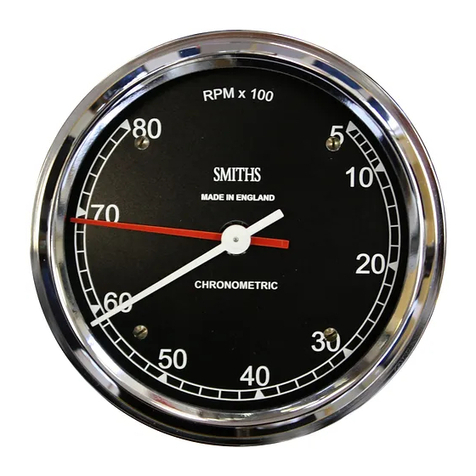
3.1 Using the push button
Having the tell-tale hand makes setting up very easy as the
red tell-tale hand shows what you are setting up and the
white main hand shows the value of the setting. The button
is used to increase the value of the setting, with a quick
push, to decrease the value with a push of about 2 seconds
and to go on to the next setting with a push of 5 seconds.
You will find this easier than it sounds!
In the following paragraphs, numbers refer to the first num-
ber on the tacho scale; e.g. when setting the cylinders to 4,
the white hand has to be set to 4000 rpm however this is
marked, maybe 4 or 40.
To enter set up mode, hold the push button down and then
apply the power. The tell-tale needle will move to 1 (the
first set up item) and the main hand will show the currently
set no of cylinders. When the needles have stopped moving,
release the button.
3.2 Number of Cylinders (tell-tale at 1)
3.5 Shift Light Settings (tell-tale at 4 and 5)
The next two settings are for the shift lights. Use the push
button to set the rpm at which you would like the first and
second shift lights to illuminate. Remember to hold the
push button pressed for 5 seconds after each adjustment to
move on to the next. After the last shift light is set, the
tacho will initialise as if it had been switched on.
3.6 Resetting the Tell-Tale
In auto reset mode, the maximum rpm recorded is shown
after switch on and the hands have been driven into the
stops. To reset this value, or the tell-tale hand when in
manual mode, simply press the push button after the tell-
tale reading has been shown.
3.1 Using the push button
Having the tell-tale hand makes setting up very easy as the
red tell-tale hand shows what you are setting up and the
white main hand shows the value of the setting. The button
is used to increase the value of the setting, with a quick
push, to decrease the value with a push of about 2 seconds
and to go on to the next setting with a push of 5 seconds.
You will find this easier than it sounds!
In the following paragraphs, numbers refer to the first num-
ber on the tacho scale; e.g. when setting the cylinders to 4,
the white hand has to be set to 4000 rpm however this is
marked, maybe 4 or 40.
To enter set up mode, hold the push button down and then
apply the power. The tell-tale needle will move to 1 (the
first set up item) and the main hand will show the currently
set no of cylinders. When the needles have stopped moving,
release the button.
3.2 Number of Cylinders (tell-tale at 1)
3.5 Shift Light Settings (tell-tale at 4 and 5)
The next two settings are for the shift lights. Use the push
button to set the rpm at which you would like the first and
second shift lights to illuminate. Remember to hold the
push button pressed for 5 seconds after each adjustment to
move on to the next. After the last shift light is set, the
tacho will initialise as if it had been switched on.
3.6 Resetting the Tell-Tale
In auto reset mode, the maximum rpm recorded is shown
after switch on and the hands have been driven into the
stops. To reset this value, or the tell-tale hand when in
manual mode, simply press the push button after the tell-
tale reading has been shown.




























